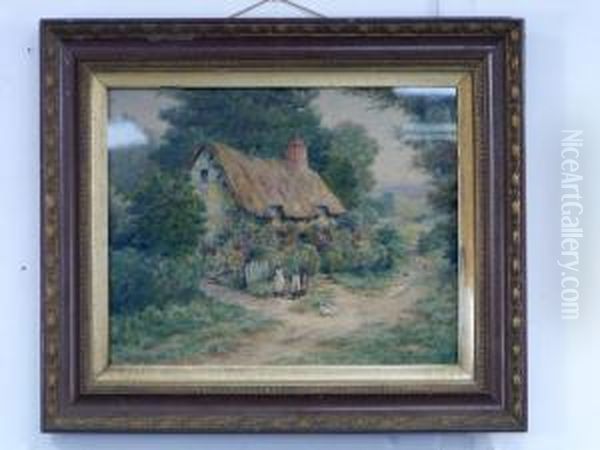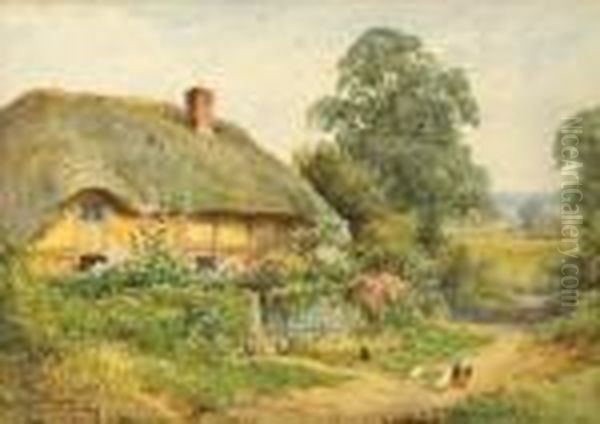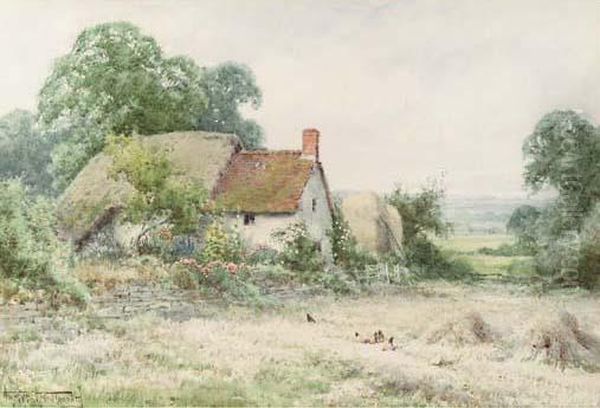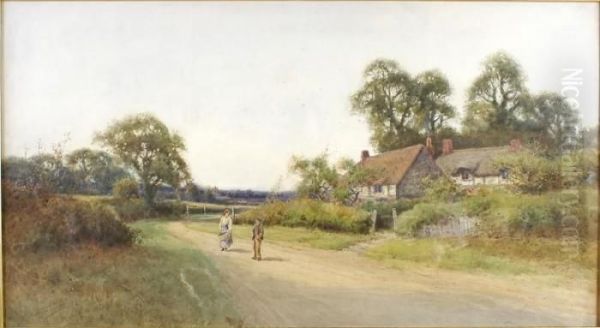
Henry John Sylvester Stannard stands as a significant figure in the tradition of English watercolour painting, celebrated for his charming and evocative depictions of the countryside, particularly the idyllic cottages and landscapes of his native Bedfordshire. Active during the late nineteenth and first half of the twentieth centuries, his work offers a nostalgic glimpse into a vision of rural England that continues to resonate with collectors and admirers today. Born into a family with artistic inclinations, Stannard carved his own niche, focusing intently on the gentle beauty of pastoral life.
His full name, confirmed as Henry John Sylvester Stannard, places him firmly within the historical record. Born on the 12th of July, 1870, he lived a long and productive life, passing away on the 12th of January, 1951. Throughout his eighty years, he remained dedicated to his craft, producing a substantial body of work that primarily utilized the delicate and expressive medium of watercolour, occasionally enhanced with bodycolour for greater opacity and depth.
Early Life and Artistic Foundations
Stannard's journey into the art world began in Bedford, England. He was fortunate to be born into an environment where art was appreciated and practiced. His father, Henry Stannard, was himself an artist, known particularly for his sporting paintings. This familial connection to the arts undoubtedly provided early exposure and encouragement for the young Henry John Sylvester. Growing up in such surroundings likely fostered his observational skills and appreciation for visual representation from an early age.
His formal artistic education further honed his natural talents. Stannard attended Bedford Modern School, a respected local institution. Following this, he pursued more specialized training at the prestigious National Art Training School in South Kensington, London (later known as the Royal College of Art). This institution was a central hub for art education in Britain, providing rigorous instruction in drawing, painting, and design. His time there would have exposed him to various artistic theories, techniques, and the works of established masters, laying a solid foundation for his future career.
The Stannard Artistic Lineage

The artistic vein in the Stannard family ran deeper than just one generation. Henry John Sylvester Stannard represented at least the third generation of artists in his lineage. His great-grandfather, John Stannard (active in the early 19th century), was also noted as a watercolourist, associated with the Norwich School of painters, although perhaps a more peripheral figure compared to giants like John Sell Cotman or John Crome. This connection highlights a continuity of artistic practice within the family, suggesting a shared sensibility or inherited talent passed down through the generations.
The family history, however, was not without its complexities and hardships, adding layers to the artist's background. Records suggest periods of financial difficulty, such as the mention of a William George Stannard facing bankruptcy. There are also intriguing, though less detailed, references to periods of mental illness affecting an earlier Henry Stannard (likely the artist's father or another relative), a poignant reminder of the personal struggles that can exist behind creative endeavours. These fragments of family history, including mentions of figures like John Lanigan Stannard and William Lanagan Stannard, paint a picture of a family navigating the social and economic realities of their time, alongside their artistic pursuits.
A particularly dramatic, though tragic, anecdote concerns the artist's great-grandfather, John Stannard. Some accounts suggest he met his end during an exploratory venture into the challenging terrain of the Tasmanian rainforest. While details might be sparse, such stories contribute to the mystique surrounding the family's past and underscore the adventurous, perhaps even perilous, paths that individuals connected to the family may have taken.
Development of a Distinctive Style
Henry John Sylvester Stannard developed a highly recognizable artistic style characterized by its detailed realism, gentle atmosphere, and focus on the picturesque aspects of rural England. His primary medium was watercolour, which he handled with considerable skill, achieving both delicate washes and precise rendering of architectural and natural details. He often favoured sunlit scenes, capturing the play of light on thatched roofs, cottage gardens brimming with flowers, and the tranquil surfaces of village ponds or streams.
His subject matter was deeply rooted in his surroundings. The county of Bedfordshire provided endless inspiration, with its rolling landscapes, quaint villages, and traditional cottages. Locations such as Flitwick (where he lived for a significant period), Riseley, and Tempsford appear frequently in his work. He had a particular fondness for depicting thatched cottages, often nestled within lush gardens, embodying a romanticized ideal of English country life that was popular during his era.

Unlike some landscape painters who focused purely on nature, Stannard often included figures in his scenes. These are typically small in scale, adding life and narrative interest without dominating the composition. Children might be seen playing outside a cottage, a woman might be feeding ducks by a pond, or a figure might be glimpsed walking along a country lane. These elements enhance the idyllic and peaceful mood of his paintings, suggesting a harmonious relationship between humanity and nature. His technique often involved careful drawing underpinning the watercolour washes, sometimes heightened with bodycolour (gouache) to add highlights or solidity to certain areas.
Representative Works and Recurring Themes
While a comprehensive catalogue of his works is extensive, several paintings stand out as representative of his style and thematic concerns. Titles mentioned in records include Still (potentially Still Life, though less common for him) and Playing with the Dog. Auction records provide dimensions for these, suggesting typical sizes for his watercolours: Still at 24.1 x 34 cm and Playing with the Dog at 34.4 x 50.8 cm. These works likely showcase his skill in composition and his ability to capture intimate moments within a rural setting.
Other characteristic titles reinforce his focus: Back of a Farmstead at Riseley, Bedfordshire, Thatched Cottage, Harvest Time, Borlase's Hill, Bedfordshire, and Rustic Bridge by the Mill, Tempsford, near St Neots. These titles clearly indicate his preferred locations and subjects. Works like A Thatched Cottage in a Landscape and A Thatched Country Cottage further emphasize his fascination with traditional rural architecture, often depicted with meticulous attention to detail, from the texture of the thatch to the blooming flowers in the garden.
The recurring themes in Stannard's work revolve around the beauty and tranquility of the English countryside. He presented an idealized vision, largely untouched by the industrialization and social changes transforming other parts of Britain. His paintings evoke nostalgia for a simpler way of life, celebrating the charm of rural England, its architecture, and its inhabitants. This focus resonated strongly with audiences seeking refuge from the complexities of modern life, contributing to his popularity.
Career Milestones and Recognition
Stannard achieved considerable success during his lifetime. An early milestone was his first significant art exhibition held in 1891 at the Bedford Corn Exchange. This event was reportedly a success, helping to establish his reputation locally. Following this, he was associated with the establishment of the Harpur Art Gallery in Bedford, demonstrating a commitment to the local arts scene beyond his own practice.

His work gained wider recognition through exhibitions at major London venues. Notably, he exhibited at the Royal Academy of Arts, a significant mark of professional achievement for any British artist. One specific, though perhaps unusual, mention records him exhibiting two watercolours depicting darts players at the Royal Academy in 1937. While seemingly divergent from his typical landscapes, it indicates his versatility or willingness to tackle different subjects, perhaps on commission.
A particularly prestigious form of recognition came through royal patronage. Queen Mary, the consort of King George V, became a significant patron of his work. Royal patronage could greatly enhance an artist's status and commercial success, and Queen Mary's interest suggests that Stannard's charming depictions of English life appealed at the highest levels of society. This support likely contributed to the steady demand for his paintings among private collectors.
Life in Flitwick and the Artistic Community
For a significant part of his career, Henry John Sylvester Stannard lived in the village of Flitwick, Bedfordshire. His time there was not only productive artistically but also placed him within a local community that included other artists. During the early 20th century, Flitwick and its surroundings attracted a number of creative individuals. Records indicate that artists such as Alfred Pearce, Inglis Sheldon-Williams, and Ina Maud Sheldon-Williams were also living or working in the area during overlapping periods.
While the available information explicitly states there is no direct evidence of formal collaborations or intense rivalries between Stannard and these contemporaries, their proximity suggests a shared environment and potential for informal interaction within the local artistic milieu. Living in an area appreciated by other artists could foster a supportive atmosphere, even if each pursued their individual styles and subjects. Stannard's deep connection to the Bedfordshire landscape was undoubtedly nurtured by his time living immersed within it, allowing him constant access to the scenes he loved to paint. His life in Flitwick, alongside his wife Alice Leslie, also involved engagement with the local community beyond purely artistic pursuits.
Stannard in the Context of British Watercolour Painting
Henry John Sylvester Stannard worked within a long and distinguished tradition of British watercolour painting. By the late 19th and early 20th centuries, the medium had a rich history, stretching back to pioneers like Paul Sandby and reaching sublime heights with masters such as J.M.W. Turner and John Constable (though Constable worked primarily in oil, his sketches influenced many). More direct predecessors in the landscape watercolour tradition included artists like David Cox and Peter De Wint, known for their atmospheric depictions of the British countryside.

Stannard's style aligns most closely with the Victorian and Edwardian taste for detailed, picturesque, and often sentimental rural scenes. He can be seen as a contemporary of artists like Helen Allingham, who became immensely popular for her meticulous watercolours of cottages and gardens, often in Surrey and Sussex. Another contemporary, Myles Birket Foster, achieved widespread fame for similar idyllic depictions of country life, often featuring charming groups of children. While Stannard developed his own distinct touch, his work shares thematic and stylistic affinities with these artists, catering to a similar market appreciation for nostalgic ruralism.
His work stands in contrast to the more avant-garde movements emerging during his lifetime. He did not engage with the stylistic innovations of Impressionism or Post-Impressionism that were influencing artists like Philip Wilson Steer or members of the New English Art Club (NEAC). Nor did his work reflect the gritty urban realism explored by painters like Walter Sickert and the Camden Town Group. Stannard remained committed to a more traditional, representational approach, focusing on capturing the perceived beauty and tranquility of the countryside, much like illustrators such as Arthur Rackham or Beatrix Potter used watercolour for different narrative ends but with similar technical finesse. His path diverged significantly from the symbolic intensity of earlier movements like the Pre-Raphaelites, whose key figures included Dante Gabriel Rossetti and John Everett Millais.
Market Presence and Enduring Legacy
Throughout his career and following his death, Henry John Sylvester Stannard's work has maintained a consistent presence in the art market, particularly at auction. His paintings appear regularly, indicating a steady demand from collectors who appreciate his quintessential English scenes. Auction results show a range of prices, reflecting factors such as size, condition, subject matter, and provenance.
Examples of works sold at auction include Harvest Time (estimated £200-£400), Borlase's Hill, Bedfordshire (estimated £150-£250), and Rustic Bridge by the Mill, Tempsford, near St Neots (estimated £150-£200). Other works like A Thatched Cottage in a Landscape carried estimates of £300-£500, while A Thatched Country Cottage was estimated at £150-£200. While these are often estimates rather than final hammer prices, they give an indication of his market level. Interestingly, records also note exceptionally low prices on occasion, with one instance citing a sale at a mere £1.05 (around $2), likely for a minor or damaged piece, highlighting the variability of the auction market.
Despite his popularity with private collectors and his consistent market presence, the available sources do not indicate that Stannard's works are held in significant numbers by major national or international public museums. His appeal seems to lie more strongly within the private sphere, cherished for their decorative qualities and their evocative portrayal of a specific vision of England.

Henry John Sylvester Stannard's legacy rests on his contribution to the tradition of English watercolour landscape painting. He was a skilled practitioner who captured the charm and beauty of the Bedfordshire countryside with affection and detail. While not an innovator in the mould of the great masters or avant-garde pioneers, he excelled within his chosen genre, creating works that offered comfort, nostalgia, and a celebration of rural life. His paintings continue to provide a window onto an idealized past, securing his place as a beloved chronicler of the English pastoral scene.
Conclusion
Henry John Sylvester Stannard remains a respected and well-loved figure within the realm of traditional British watercolour art. Born into an artistic family and formally trained, he dedicated his long career to depicting the landscapes and cottages of Bedfordshire. His detailed, sunlit scenes, often populated by figures engaged in quiet rural activities, captured an idyllic vision of England that found favour with patrons, including royalty, and continues to appeal to collectors today. While not associated with major artistic movements, his consistent output, technical skill, and charming subject matter ensure his enduring legacy as a painter who beautifully captured the gentle essence of the English countryside.